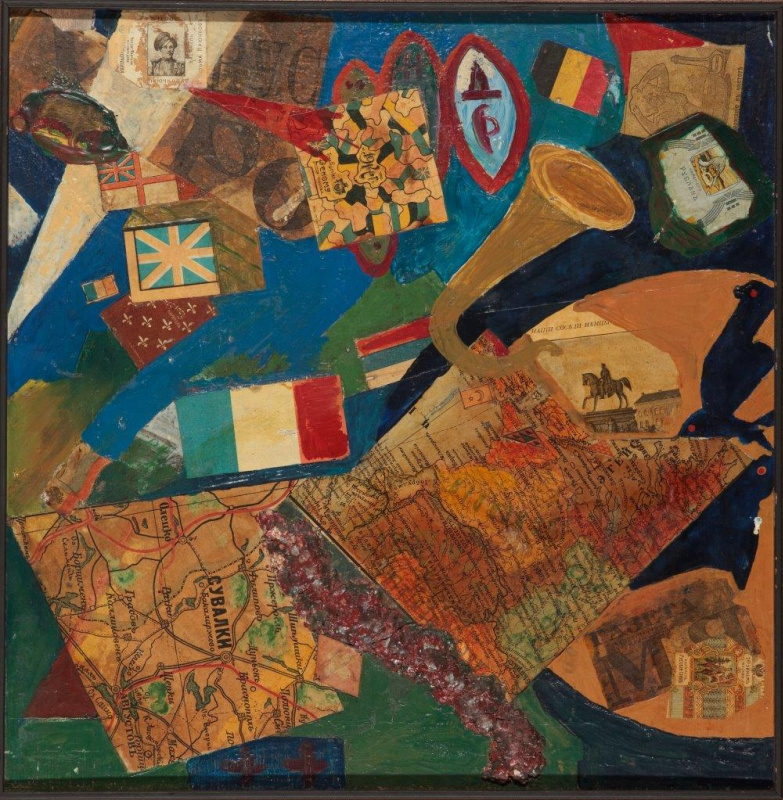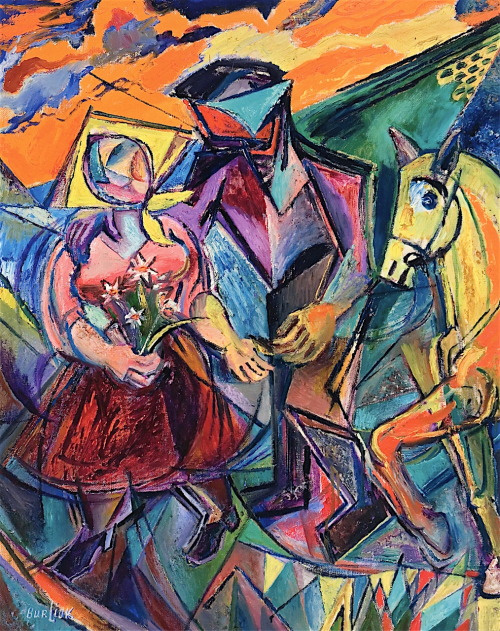The beginning of the 20th century was marked by a powerful surge of inventions that changed and significantly accelerated the rhythm of human life. These were radical, epoch-making, absolutely fantastic innovations: airplane and wireless telegraph, electric welding and electric incandescent lamp, cinematograph, X-ray machine, reinforced concrete, photographic film... The future has come! Technological progress shook civilization to its very foundations and influenced all branches of human knowledge, including literature and art. Everything classical and academic has remained in the past – the time has come for the search for self-expression, bright personalities and new ideas: the time of futurism.

Cubo-Futurism. The Italian beginning
In Italy in 1909, and soon in France, the Futurist Manifesto was published, in which the poet Filippo Tommaso Marinetti glorified progress, industrial development and mechanization of production, as well as opposed obsolete social and cultural institutions. The ideas of the poet were supported by Milanese artists — first of all, Umberto Boccioni, as well as Gino Severini, Carlo Carra, Giacomo Balla, who believed that all this can and should be brought into modern fine art. Exploring the properties of space and movement, the Italian Futurists were certainly intent upon making “bituminous shades” and “nudes” things of the past. The dynamic sensation of a comprehensive forward movement was their new god whom art had begun to worship.
Elasticity
1912, 100×100 cm

In 1914, Marinetti published his novel “Zang Tumb Tuuum”, which described one of the episodes of the Balkan War – the history of the siege of the Turkish city of Adrianople by the Bulgarians, which he witnessed as a military journalist. In this work, the poet “did” without punctuation, syntax and adjectives, using only the infinitive form of verbs and symbols. The dynamism of the narrative was enhanced by the graphic solutions of the book, various fonts and their design – the distinctive techniques of Futurism. Photo Source
Collage on the theme of the First World War
1915, 49×48 cm
Russian Futurism
The movement of Russian Futurists began to develop almost simultaneously with the Italian one. In 1910, the first Futurist society arose, which included poets, writers and artists Velimir Khlebnikov, the Burliuk brothers, Vladimir Mayakovsky, Vasily Kamensky, Alexei Kruchyonykh and others. Khlebnikov called his comrades in the new art bydetlyany, which meant that they were people who would be. The participants of the movement in every possible way emphasized their independence from Italian futurism of Marinetti, flouted the old art, which featured “carrion, pessimism, philistinism and vulgarity”. In 1910, the bydetlyany named themselves the Gileia (Hylaea) poetry group. In the same year, the group’s first almanac A Trap for Judges (Sadok Sudei) was issued. The book was printed in an edition limited to 300 copies in the St. Petersburg Zhuravl publishing house on... three kinds of wallpaper. David Burliuk wrote, “...we’ll go through your whole life with fire and sword of literature: under your wallpaper, you had bugs and cockroaches, let our young, peppy poems live on them now."

Cover of A Trap for Judges almanac. Mayakovsky State Museum, Russian Federation
It was a challenge to professional literature. “Boyish antics and bad taste” of the bydetlyany teased critics, but there were also such writers who sided with the Futurists. Two years later, the "Slap in the face of public taste almanac" (in which, by the way, Mayakovsky made his debut) was issued, accompanied by the manifesto with the same name, and this was already a real scandal. “...Only we are the face of our Time. We blow the horn of time in verbal art. The past is too tight. The Academy and Pushkin are incomprehensible like hieroglyphs. Throw Pushkin, Dostoevsky, Tolstoy etc. etc. out from the Steamboat of Modern Age. He who does not forget his first love, never knows his last one.” “It is necessary that it be read tight... impudent and rough!” - the bydetlyany wrote in their “Declaration of the word, as such”.






The “Father of Russian Futurism” David Burliuk was a wonderful organizer who rallied interested artists and poets around him and was able to masterfully maintain internal relations among Futurists. Burliuk organized exhibitions, wrote manifestos, financially supported friends and was inexhaustible with the ideas of new actions. “Big stormy Burliuk bursts into life. He is wide and greedy. He needs to know everything, capture everything, eat everything up. A complex figure,” wrote Alexei Kruchyonykh about him. Burliuk experimented constantly, he did not hesitate to change his artistic style, moving from impressionism to folk art, weaving cubic elements in his canvases and turning to primitivism. Later, having left Russia, the artist became the discoverer of new art in Japan, and later in the USA.
Engagement
1910, 127×97 cm
“Reason has been overthrown, the whole world is irrational, but what is strange: this is not enough for them. Freedom, let be freedom to the end! Ruin, then let them ruin everything!.. This is a rebellion against everything without exemption, an eternal, primordial, indigenous Russian nihilistic, anarchist rebellion, our eternal nechaevism, and this is a complete coincidence that now it has covered itself with Futurism. We don’t need any Marinetti, we have ours in abundance – saryn go to kichka, we strike and burn!”
Korney Chukovsky, Cubo-Futurists, 1913
Morning
Start XX centuries, 15×14 cm
David Burliuk.
Summer
Ленивой лани ласки лепестков
Любви лучей лука
Листок летит лиловый лягунов
Лазурь легка
Ломаются летуньи листокрылы
Лепечут ЛОПАРИ ЛАЗОРЕВЫЕ ЛУН
Лилейные лукавствуют леилы
Лепотствует ленивый лгун
Ливан лысейший летний ларь ломая
Литавры лозами лить лапы левизну
Лог лексикон лак люди лая
Любовь лавины = латы льну.
1911
Shocking and posturing, and even deliberate trickery – the Futurists widely used all these techniques, from Mayakovsky’s yellow jacket to face painting and bunches of radishes in buttonholes. The ideas of the poets were picked up by artists – the Jack of Diamonds association, Donkey's Tail and the Soyuz Molodyozhi. The main goal of the Futurist art movement was the final break with academicism. As Mikhail Larionov and Ilya Zdanevich wrote in their Why We Paint Ourselves (1913) manifesto, “... we combined art with life ... we called life loudly, and life invaded art ... Painting of our faces is the beginning of the invasion”.
Summer
Ленивой лани ласки лепестков
Любви лучей лука
Листок летит лиловый лягунов
Лазурь легка
Ломаются летуньи листокрылы
Лепечут ЛОПАРИ ЛАЗОРЕВЫЕ ЛУН
Лилейные лукавствуют леилы
Лепотствует ленивый лгун
Ливан лысейший летний ларь ломая
Литавры лозами лить лапы левизну
Лог лексикон лак люди лая
Любовь лавины = латы льну.
1911
Shocking and posturing, and even deliberate trickery – the Futurists widely used all these techniques, from Mayakovsky’s yellow jacket to face painting and bunches of radishes in buttonholes. The ideas of the poets were picked up by artists – the Jack of Diamonds association, Donkey's Tail and the Soyuz Molodyozhi. The main goal of the Futurist art movement was the final break with academicism. As Mikhail Larionov and Ilya Zdanevich wrote in their Why We Paint Ourselves (1913) manifesto, “... we combined art with life ... we called life loudly, and life invaded art ... Painting of our faces is the beginning of the invasion”.

Art critic Andrei Shemshurin, artist David Burliuk and poet Vladimir Mayakovsky, 1913
Cubo-Futurists widely used such techniques as application and collage in their works. The collaboration of artists and writers led to the creation of numerous joint projects in the field of books, where texts and images complemented each other. The unity of word and image was proclaimed by Natalia Goncharova, Mikhail Larionov, Pavel Filonov, Aristarkh Lentulov, Vasily Chekrygin, Vladimir Tatlin. “Specializing in one kind of art is very boring,” the artist Olga Rozanova thought, and under the influence of Alexei Kruchyonykh she began to write non-objective poetry.
Futuristic
1915
Olga Rozanova. “Spain”
Вульгарк ах бульваров
Варвары гусары
Вулье ара-бит
А рабы бар арапы
Тарк губят тара
Алжир сугубят
Ан и енно
Гиенно
Гитана.
Жиг и гит тела
Висжит тарантелла
Вира жирн рантье
Антиквар
Штара
Квартомас
Фантом
Илька негра метресса
Гримасы
Гремит
Гимн
Смерти
Вульгарк ах бульваров
Варвары гусары
Вулье ара-бит
А рабы бар арапы
Тарк губят тара
Алжир сугубят
Ан и енно
Гиенно
Гитана.
Жиг и гит тела
Висжит тарантелла
Вира жирн рантье
Антиквар
Штара
Квартомас
Фантом
Илька негра метресса
Гримасы
Гремит
Гимн
Смерти
Rejecting the past, Russian Futurist artists drew inspiration not only from technological progress. One of the sources of their ideas was the traditional Russian heritage, folk crafts and religious views. Russian primitivism – lubok and folk costume, ancient pagan sculptures, icon painting – all this acquired abstract forms and pure colours. Another distinguishing feature of the futurists is the representative female component of the movement. Natalia Goncharova, Lyubov Popova, Olga Rozanova occupied an outstanding place in the art movement. Many of these women travelled or lived outside of Russia, where new ideas about equality flourished in cosmopolitan cities.
Factory
1912, 102.5×80 cm
Natalia Goncharova turned to folk art, drawing inspiration from traditional lubok and developing a new direction of neo-primitivism. Later, together with her husband Mikhail Larionov, they developed their own avant-garde art style – "rayonism" (fr. rayon — “ray”). “Rayonism is still based on objects – but it gets away from it. Surrounding reality is only an excuse for crossing the rays that interest the rayonism artist. Not only objects, but also our feelings, impressions and ourselves – everything is displayed in the form of rays”, Larionov explained the principles of the new style. According to the followers of rayonism, their painting was a synthesis of Cubism, Futurism and Orphism, and Vladimir Mayakovsky considered rayonism a cubist version of impressionism. The spatial structure of these paintings was based on colour combinations, saturation, rich colours and energy vectors
For Кazimir Malevich, Cubo-Futurism became an intermediate state between static cubism and manifestations of movement and dynamism. Combinations of the recognizable forms of realistic objects and geometric objectless planes, combined into peculiar riddles, are typical for many of the artist’s works, painted during 1912—1914.
It is likely that Italian Futurism, which was widely covered by the European press, influenced the formation of Russian Futurism. However, when in 1914 Marinetti came to Russia and made such a statement, he was received with hostility. Russian artists advocated the primordial nature of their artistic movement, “... and we believe that this is not a pose, a whim, but an organic, genuine feeling that disharmony, dissymmetry, imbalance were actually charming to them” (Korney Chukovsky)
The objective reality of the First World War led to a personal rethinking of the historical moment for all creative people. Artists painted military posters and postcards, some were drafted into the army, some evacuated or emigrated. The terrifying realities of war, famine and deprivation left no room for futuristic word and image games. By 1915, the Russian avant-garde artists entered a new round of development – the non-objective art. The Last Futurist Exhibition of Paintings 0,10, held in St. Petersburg in 1915, began new movements in Russian avant-garde art – Suprematism by Kazimir Malevich and constructivism by Vladimir Tatlin, prouns of El Lissitzky and photographic experiments by Alexander Rodchenko.




















